Livorno
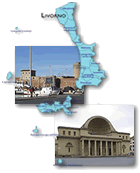
Livorno is the most important of the Italian cities founded in the modern age. Since its origin, dating to the mid 16th century, the city’s destiny has been closely tied to water. Its port constituted one of the most demanding and vanguard undertakings in Italy in the 16th and 17th centuries. Suffice it to consider the Venezia Nuova quarter, traversed by canals specially dug to increase the wharf area to the utmost, following the example of Amsterdam. In the 19th century, these works were joined by imposing hydraulic works to build an aqueduct that would make up for the city’s century-old shortage of fresh water.
The Cisternone is the monumental point of arrival of the aqueduct built under the Lorraines.
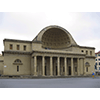
An impressive building in the neoclassical style, the "Cisternone" was designed by Arezzo architect Pasquale Poccianti and inaugurated by Grand Duke Leopold II of Lorraine in 1842. The large cistern, whose construction began in 1828, was intended to filter the water from the springs of Colognole and guarantee the supply of water to the city, in case of aqueduct malfunction. The cistern measures 38 metres in width, 42 metres in length, and has a capacity of 11,000 cubic metres.
In his Guida di Livorno, Giuseppe Piombanti describes the building, «On crossing the threshold, one enters a semicircular atrium. In the room on the left, from a massive cast-iron tube that reaches all the way to the Little Cistern of Pian di Rota, flows the water of Colognole, while below the atrium are the canals that take it to the Little Cistern and the other fountains. In front of the middle door of the atrium extends the large cistern of five aisles in width and seven in length; the last of these, separated by an intermediate wall, is the first to receive the waters, severing as a sort of purgatory, and then pours them into the internal repository».
The facade of the recently restored building presents a characteristic half cupola. A curiosity: the affairs in the construction of Livorno’s water system are celebrated in a bas-relief sculpted on the base of the statue erected in honour of Grand Duke Ferdinando III of Lorraine in Piazza della Repubblica. The statue was executed by Portoferraio sculptor Francesco Pozzi between 1831 and 1837, while the bas-relief depicting the Grand Duke urging the construction of the Colognole aqueduct is by Temistocle Guerrazzi from Livorno. The other bas-relief portraying Ferdinando III promoter of the arts, industry and commerce, was sculpted by Ulisse Cambi from Florence.
(Graziano Magrini)
Its grandiose neoclassical architecture closely recalls that of the Cisternino in the nearby Piazza Guerrazzi, which is accessible by taking Via De Larderel and passing Piazza della Repubblica.
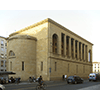
An elegant example of neoclassical architecture in a city context, the "Cisternino" is the last of the three large cisterns designed by Paquale Poccianti (the other two are the "Cisternino" of Pian di Rota and the "Cisternone" of Livorno). It has a rectangular plan with a semicircular apse. An elegant portico of Ionic inspiration rises on the massive base on the side facing the Via Grande.
The cistern was intended to receive water from the Colognole Aqueduct and then, by means of a system of pipelines and tunnels designed by Livorno architect Angelo della Valle, to supply the city fountains. The building, however, never came into use. It currently houses a venue for cultural activities and, on the lower floor, a theatre.
(Graziano Magrini)
Continuing northbound for a short distance, you see the impressive mass of the Fortezza Nuova, which was completed astride the 16th and 17th centuries and dominates the Venezia Nuova district.
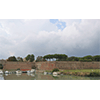
Conceived on the basis of designs by many artificers (Bernardo Buontalenti, Giovanni Cantagallina, Vincenzo Bonanni, Giovanni de’ Medici), the massive "New Fortress" was built astride the 16th and 17th centuries. Though built later, it was part of the great project for Livorno as city-fortress that Grand Duke Francesco I de’ Medici commissioned from Buontalenti. Part of the Fortezza Nuova was demolished (including the curtain wall joining it to the Fortezza Vecchia or "Old Fortress") in 1629 to permit the construction of the picturesque quarters of Venezia Nuova and San Marco, ordered by Grand Duke Ferdinando II de’ Medici.
The Fortezza Nuova presents a polygonal plan and a well-structured interior, which is entered from the bridge on the docks. It was used for military purposes until the end of World War II. Following various uses, in 1972 it was restored by the Commune of Livorno, and the upper part was made a public park.
(Graziano Magrini)
Proceeding towards the western part of the city, where the rigorous sixteenth-century geometric layout is still visible, you reach the harbour area with its abundance of tokens from the past. The port from which both Amerigo Vespucci and Giovanni da Verrazzano set sail appears defended by a splendid example of Renaissance military architecture, the Fortezza Vecchia, which was finished in 1534.
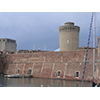
Built on a project by Antonio and Giuliano da Sangallo as an enlargement of the square fortalice (known as the "Pisans’ quadrature") erected next to the Mathilde stronghold, the Old Fortress was also the Livorno residence of Cosimo I de’ Medici who, in 1544, ordered the construction of the Palazzotto on the Canaviglia bastion that commanded the entrance to the port. Cosimo, then duke of Florence, also had a famous cistern excavated, the water of which was praised by Francesco Redi.
On April 2, 1662, the tower of the Fortress was the theatre for observations on the motion of projectiles, conducted by Cimento academicians to experimentally confirm the conclusions of Galileo Galilei. Between late 1657 and early 1658, the city of Livorno had also been the scene of several experiments by the Cimento academicians on "congealments", that is to say on the freezing of liquids.
The Fortress was not only a place for the experimental verification of physics, but also a site of "naturalistic observation". In his Guida di Livorno, Piombanti tells of how, in October 1734, a storm had beached a whale at the foot of the Fortress, and of how the event recurred in January of 1753, when two cetaceans were killed near the port with cannon-shots fired from the bastion above.
(Graziano Magrini)
The port itself, visible in its entirety from Via del Molo Mediceo, represents an important example of multilayered port engineering, indeed ranging from medieval tokens up to the imposing curved walls built in the mid 19th century.
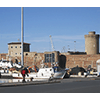
It was ordered by Cosimo I de' Medici, but built only in the years after his grand duchy. The original project provided for the construction of two parallel piers which were supposed to reach, respectively, the Fanale dei Pisani and the Old Fortress. The construction of the first arm, ordered by Ferdinando I, came to a halt sooner than expected, on the Sassaia reef, while the second was built under Cosimo II. The same years also witnessed the outfitting of the extensive dockyard opposite the Old Fortress and the completion of the navigable canal between Pisa and Livorno. Protected by a chain of rocks, removed in 1864, the port could not contain many vessels due to the shallow depth of water. Lazarettos were built some distance from the port to quarantine boats arriving from countries that might have spread epidemics.
Significant operations were conducted by the last Grand Duke of Tuscany, Leopold II. In 1852, he ordered the construction of an impressive curved wall, 800 metres from the old pier. 1130 metres long and an average of 8.50 metres deep, the new port was 400 metres from the Fanale dei Pisani. A canal was excavated in the middle of the old pier, to enable the transit of ships that had to enter the shipyard dock for repairs. Furthermore, in order to make communications between the sea and land and between ships and the railway easier and faster, he decided to build the harbour station. Designed by engineer Giuseppe Laschi, the construction of the station began in 1856: for this purpose, a vast tract of sea was filled, a four-sided dock was build for the convenience of boats, and large warehouses were erected along its sides where goods could be stored. On the land side, a building for offices was erected, while a smaller building was erected in the water to house the financial police. Before reaching the station of San Marco, the railway crossed the Navicelli Canal by means of an iron revolving bridge, reached the dock and then continued along the entrepôt piers. The harbour station was inaugurated on August 12, 1858.
The Medici port of Livorno is a scientific site associated with the name of Galileo Galilei. Between 1590 and 1592, don Antonio de' Medici proposed a machine to empty the dock of Livorno, and according to the account of Vincenzo Viviani in Racconto istorico, Galileo expressed a negative opinion.
The Pisan scientist also used the port for several experiments with the telescope. On March 22, 1617, Galileo wrote from Pisa to Curzio Picchena, describing the experiment conducted with the celatone, a device conceived to utilise the telescope onboard a ship, even with moderate seas. Galileo declared that he had been able to verify the effect of the spectacle only onboard a small boat inside the dock, as there were no vessels outside the dock. Though the wind was very strong, there was little wave motion and that little motion did not damage the use of the spectacle.
(Graziano Magrini)
A short distance from the Medici dock, on the western end of the modern port area, rises the soaring mass of the "Pisans’ Lighthouse", a site that abounds with Galilean memories.
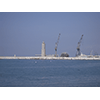
About 400 metres from the Medici pier and 52 metres tall, the "Pisans’ Lighthouse" is formed by two superimposed crenellated towers with a truncated cone base. It was destroyed by bombings in 1944 and rebuilt in 1955. The original must probably be attributed to Giovanni di Nicola Pisano, who built it in the same years that he was working on the pulpit of the Cathedral of Pisa. The edifice was built near the city to replace the Meloria Tower, sited on the shoals west of Livorno and irremediably damaged by the Genoese in the famous homonymous battle (1284), which saw them victorious over the Pisans.
Florentine chronicler Goro di Stagio Dati defined the Fanale as one of the most beautiful lighthouses in the world; it is even believed that it was the source of inspiration for Dante Alighieri in his famous verses «stand like a sturdy tower that does not shake / its summit though the winds may blast» (Divine Comedy, Purgatory, V, 14-15). The tower is also reported by Francesco Petrarch in his Syriac Itinerary as «very effective, every night, the flame on top guides sailors to the safest shore». By order of Grand Duke Francesco I de’ Medici, in 1584 it housed a lazaretto. The tower is also an emblematic site tied to Galileo Galilei who performed numerous experiments here to fine-tune his telescope.
(Graziano Magrini)
****************************
Texts by Elena Fani
English translation by Victor Beard
Last update 21/ott/2008



 = libraries and archives
= libraries and archives  = scientific research centers
= scientific research centers  = memorial places of scientists
= memorial places of scientists = public health places
= public health places = places of science and worship
= places of science and worship = places of technology
= places of technology  = museums and collections
= museums and collections  = villas and gardens of science
= villas and gardens of science
